
The use of Environmentally Friendly Materials and Techniques in Road Construction

When you strive to reduce your impact on the environment, you need to focus on sustainability in road construction. Many traditional road construction methods use materials and techniques that produce significant environmental impact, such as the use of non renewable resources, the emission of greenhouse gases, and the creation of waste. It is possible to reduce the environmental impact of road construction using environmentally friendly materials and techniques.
Recycled Materials
Utilizing recycled materials is one way to build roads in a sustainable manner. The carbon footprint of building roads can be considerably reduced by recycling materials like asphalt and concrete. This is so that less garbage is dumped in landfills and less energy is needed to generate new materials as a result of recycling these resources.
As an illustration, employing recycled asphalt pavement while building roads can save greenhouse gas emissions by as much as fifty percent. Similar to this, employing recycled concrete aggregate can cut down on the amount of waste dumped in landfills and the demand for new resources while building roads.
Low Carbon Concrete
It is widely used in road construction as one of the most common materials. The country produces about thirty five percent of all concrete around the world. This material is resistant to freezing temperatures, extreme heat, and humidity levels as well as having a high compressive strength. As well as providing good riding characteristics on highways, concrete is also strong enough to support heavy loads such as trucks or passenger cars.
The production of concrete requires a considerable amount of energy and produces significant amounts of carbon dioxide. Around five percent of global CO2 emissions come from cement production. By reducing cement use and substituting fly ash and slag for some cement, you can reduce these emissions.
As a by-product of steel making or aluminum smelting, fly ash is produced during coal-fired power generation. By switching from Portland cement to low carbon alternatives such as fly ash or slag, concrete production could significantly reduce greenhouse gas emissions.
Low Carbon Materials
Utilizing low carbon materials in addition to recycled resources can help to lessen the environmental impact of road construction. For instance, warm-mix asphalt emits fewer greenhouse gases because it uses less energy to generate than conventional hot-mix asphalt.
The amount of carbon emissions linked to cement manufacture can also be decreased by using concrete with less cement. You can encourage sustainable growth and drastically lower the carbon impact of road construction by utilizing these materials.
Green Pavement
Green pavement is a different strategy for attaining sustainability in road building. Green pavement is a term used to describe pavement that allows water to seep into the ground, hence lowering storm-water runoff and enhancing water quality. Permeable pavement and porous asphalt are two types of green pavement.
While porous asphalt has a particular mix which enables water to drain past the pavement and into the soil below, permeable pavement is comprised of components that allow water to pass through the surface and into the earth. We can improve water quality and decrease storm-water runoff by adopting green pavement, which encourages sustainable growth.
Energy Efficient Lighting
Energy efficient lighting can help to cut down on energy use and greenhouse gas emissions in road construction projects in addition to adopting environmentally friendly materials. For instance, adopting LED lights instead of conventional illumination for street lighting can save up to 75% on electricity. You can decrease the amount of energy used by road infrastructure and encourage sustainable growth by utilizing energy efficient lighting.
Smart Transportation Systems
Implementing intelligent transportation systems is another strategy for improving sustainability in road development. Intelligent transportation systems and linked vehicle technologies are both parts of smart transportation systems. These devices can aid in easing traffic, enhancing mobility, and lowering car emissions.
An intelligent transportation system can give drivers access to real time traffic data, which can assist them avoid gridlock and cut down on trip time. Similar to how automobiles may communicate with each other and with traffic infrastructure, connected vehicle technology can help to enhance traffic flow and prevent accidents.
You can lessen the negative effects of vehicle travel on the environment and encourage sustainable development by putting these systems in place.
Define Sustainable Highway
Highways that are sustainable are designed, constructed, and maintained to minimize their negative impacts on the environment, including people's health and safety, wildlife habitats, and other natural resources.
The goal of these highways is to minimize the environmental impact while reducing maintenance costs. Planning, construction, maintenance, and eventual decommissioning of highways must also be considered when designing sustainable highways.
Which Sustainable Method is best for Road Construction?
Recycling materials, using low carbon products, and using renewable energy are some of the most sustainable ways to construct.
Reduced landfill space and reduced need for new resources can be achieved by recycling materials. New materials are also produced with less energy when recycled. A lot of emphasis should be placed on this when it comes to asphalt. Natural gas and crude oil, which are nonrenewable resources, are used to make asphalt.
To learn more, watch the following video tutorial.
Video Source: Federal Highway Administration USDOTFHWA
Wrapping it Up
With the use of environmentally friendly materials and methods that lessen the environmental impact of infrastructure development, sustainability in road construction can be achieved.
You may build infrastructure that is environmentally responsible and aids in lowering our carbon footprint by employing recycled materials, low carbon materials, green pavement, energy efficient lighting, and smart transit systems. These strategies encourage sustainable growth and may assist us in creating a more sustainable future.


